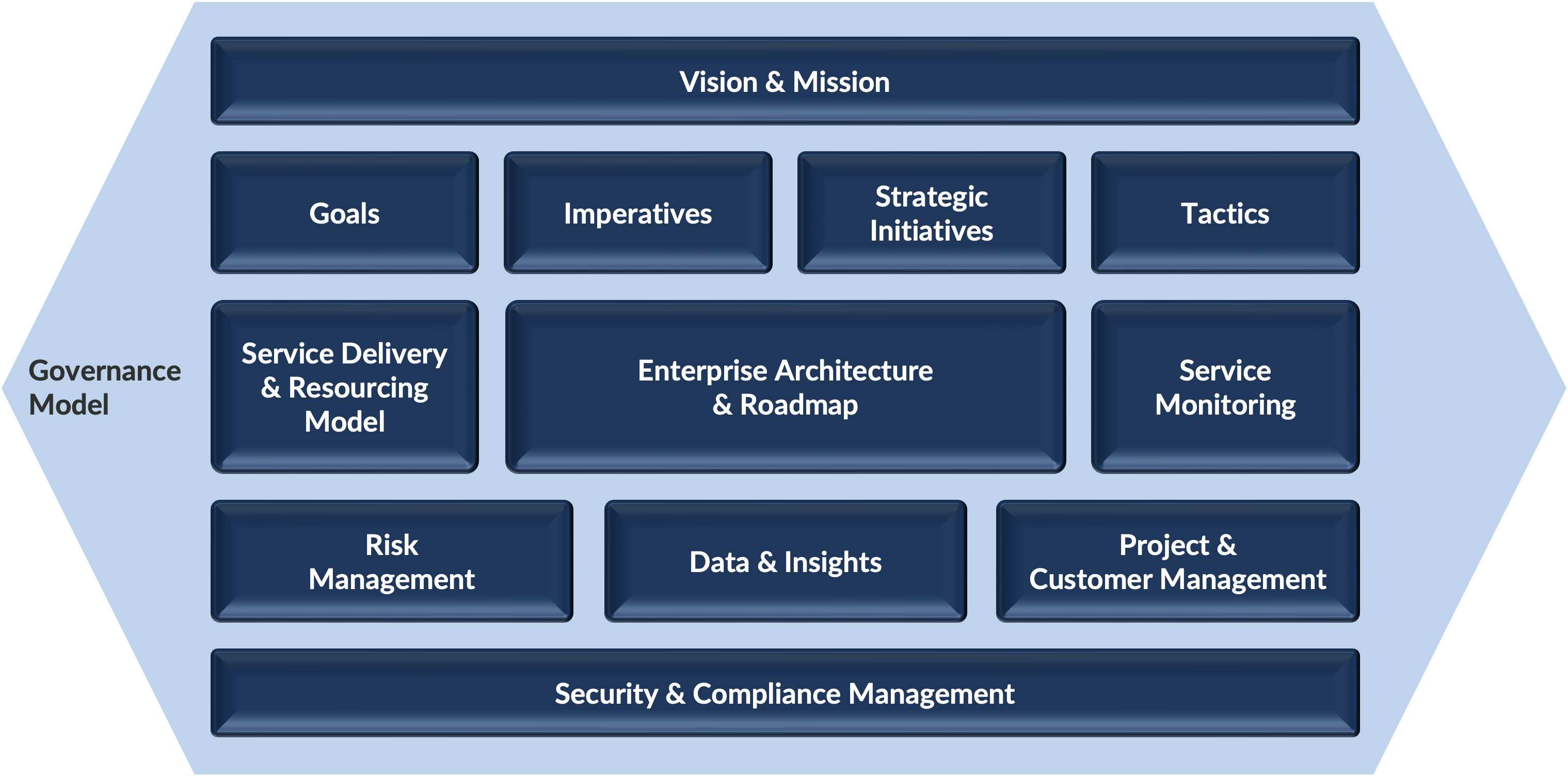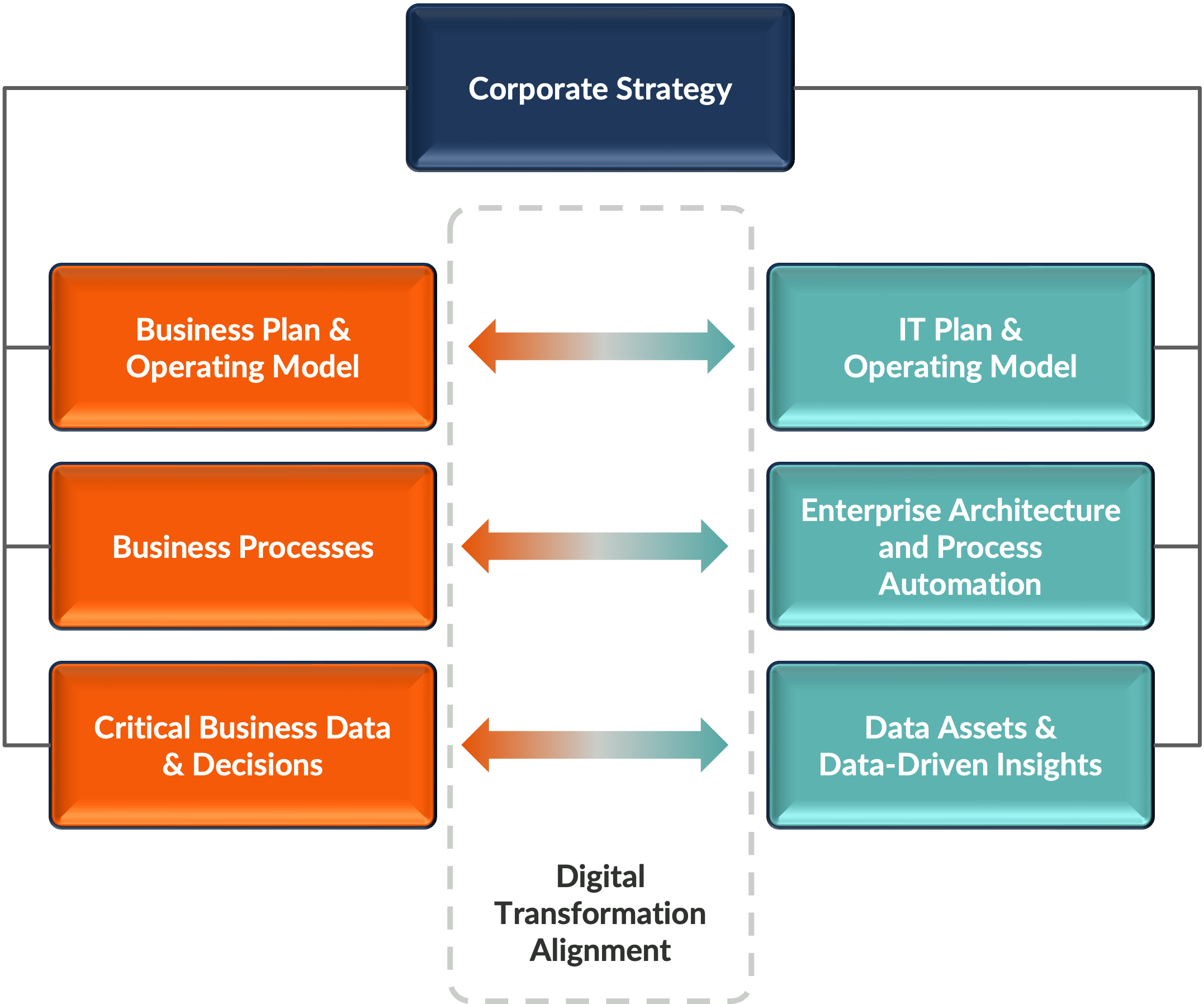Life sciences organizations are often growing faster than their ability to plan and scale their operating infrastructure. As medical innovation and market competition continue to accelerate, organizations are looking for ways to better align their business strategies and their technology plans. For many of these firms, the time is right for building a better IT strategy.
The Purpose of an IT Strategy
An IT strategy offers a disciplined way of understanding how an organization intends to pursue its growth goals through supporting technology (e.g., hardware, software, data). IT strategies answer questions like:
- How will technology-related people, processes, and assets support business operations and expansion?
- What technology-related investments, expenses, and resources are needed, and how is the organization prioritizing and making decisions about those needs?
- When and how are new technology-related capabilities being introduced to the business?
- How will technology-related services be delivered, measured, and supported?
- What technology-related standards will be used to help the business scale?
- What “big bets” is the organization placing with technology and why?
- What is the role technology will serve in the organization’s competitive posture?
- How will the organization protect itself from technology-related risks?
- How can technology create a competitive advantage in the services the company provides and how the company operates?
The Symptoms of an Under-Developed IT Strategy
Virtually all companies have information technology, but many of them lack a disciplined approach for IT or digital transformation strategy development. And those gaps can be painful. Organizations that lack a sufficiently mature IT strategy exhibit a wide variety of symptoms, including:
- Poor IT service levels: executives and end users report low customer satisfaction levels with IT-related products and services.
- Under-performing post-merger integrations: organizations that were expecting to realize operational synergies are unable to capture the expected economic benefits.
- Disagreements on IT goals and priorities: executives do not share a common view on technology-related growth plans, opportunities, and investments.
- Under-/ mis-aligned investments: IT-related initiatives are not directly driving the development of capabilities seen as critical to the organization’s growth.
- Unclear IT decision-making processes: executives do not understand what technology-related issues have been considered, by whom, and why decisions were reached.
- Inability to integrate data and automate business processes: the organization struggles to leverage IT and data through a well-managed business architecture that drives business performance.
- Outdated technology: important business processes are running on obsolete hardware, software, or other infrastructure assets, putting the business at risk.
- Elevated IT costs: technology-related costs as a percentage of total revenue are high as compared to market peers.
- Elevated risk profiles: the organization is experiencing a relatively high number of security, regulatory, or operational risks related to its technology assets and processes.
These symptoms can be particularly acute for life sciences organizations. The heterogeneous nature of the work itself — rapidly evolving science, extensive partnerships, variability in research designs, disparate data sources and types, multiple geographic and regulatory considerations — continuously challenge industry leaders to align their IT service delivery capabilities with the changing landscape. Thankfully, a well-formed IT strategy can help.
The Benefits
Life sciences organizations are competing in an economy where technology-related capabilities differentiate market leaders and laggards. Organizations that take a little time to develop a disciplined approach to their IT strategies enjoy a plethora of benefits, including:
- Reduced security and compliance risks. As variability often translates into increased security, regulatory, and quality problems, a strong IT strategy enables organizations to reduce risks through technical standardization and process consistency.
- Increased competitiveness. Organizations that have a solid technology foundation are better positioned to respond to emerging competitive threats and exploit new business opportunities.
- Improved operational insights. When organizations adopt a standards-based enterprise architecture, IT is better positioned to integrate data across systems and silos to provide insights into critical performance measures.
- Happier workers. Business executives and end users want a voice in how technologies are driving the business, and their alignment accelerates the speed and effectiveness by which the organization adopts technical innovation.
- Better future scale. Emerging technologies, data, and analytics such as AI are now pivotal capabilities for life sciences product innovation, development and service delivery.
- Improved operational resilience and service levels. IT organizations that have clear strategies, well-defined enterprise architectures, and clear performance standards deliver better, more reliable technology services.
- Increased M&A efficacy. Effective IT strategies and roadmaps a) produce more attractive M&A prospects, b) lower the complexity of M&A due diligence, c) accelerate post-merger integration activities, d) reduce integration risks, and e) create stronger economies of scale in the resulting organization.
- Avoided technical debt. IT roadmaps enable organizations to transition earlier and easier to more modern, well-supported infrastructure.
- Reduced IT costs. IT strategies enable organizations to reduce and eliminate unnecessary IT costs sooner, preserving capital and resources for higher-value purposes.
- More efficient resource utilization. With fewer things to support and more consistent ways of supporting them, IT resource utilization is improved.
The Importance of Disciplined Approach
Inexperienced business leaders sometimes mistake building an IT strategy with making buying decisions. When IT is not seen as a critical enabler of business growth or competitive differentiation, it is easy to assume that IT strategy boils down to managing expenses as opposed to unlocking scalable growth. Moreso today than ever before, it is important to get the balance right.
The good news is that well-developed IT strategies enable organizations to accomplish both goals – managing expenses while supporting business growth. The work starts with aligning the organization around a strategic planning and governance framework grounded in proven best practices (see Figure 1 for an example).

Figure 1. CREO’s IT Strategy Framework (ITSF).
Ideally, the IT strategy framework aligns to the organization’s business strategy framework. For example, CREO uses a strategic planning methodology called ISEP to help guide clients through quarterly, annual, and long-term planning activities. Our IT Strategy Framework (ITSF) above integrates with ISEP, enabling business leaders to understand and trace the dependencies between their business growth goals and the corresponding technology investments needed to support achieving those goals. As business and IT leaders collaborate on these plans, they can more easily explore options and reach a consensus on technology initiatives that drive the right value for the organization.
It is important to note that though the framework is comprehensive in scope, the implementation is scalable to organizations ranging from small start-ups through multi-national corporations. There is no one-size-fits-all approach to IT strategy; the goal is fit-for-purpose planning sized appropriately and tuned to the unique aspects of the organization’s business model.
One way of thinking about how to scope the effort is to reflect on the following: what would be the operating model, core business processes, and key data that would drive a digitally transformed business in this market space? Digital transformation strategies – one form of an IT strategy – focus on using technology as a key enabler of the organization’s most critical operational processes and customer experiences (see Figure 2). When organizations frame IT strategies as digital transformation journeys, it becomes clearer where IT can best drive value creation for the business.

Figure 2. Digital Transformation Alignment
If you are interested in learning more about how IT and digital transformation strategies can accelerate life sciences business-IT alignment and value creation, CREO can conduct on-site workshop for your team that enables leaders to interactively explore these opportunities. Visit our Contact Us page and leave us your contact information and interest, and one of our experts will follow up with additional details.
 Jason Burke | June 12, 2023
Jason Burke | June 12, 2023


